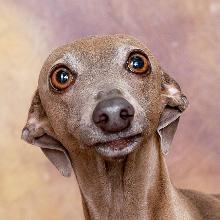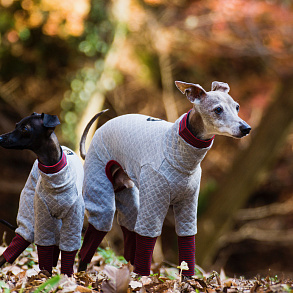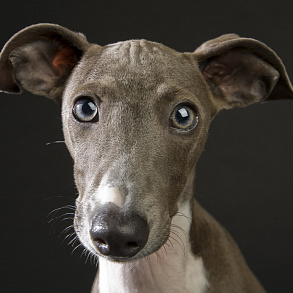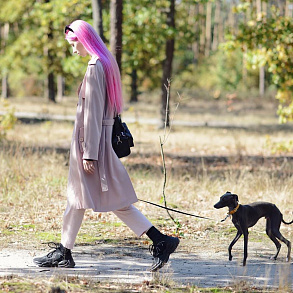Levretka

Levretka is the smallest and most temperamental representative of the greyhound clan. Playful, sociable, does not tolerate inattention to her own person.
Brief information
- Breed name: Levretka
- Country of Origin: Italy
- Time of origin of the breed: 20-30 years of the XX century
- Weight: maximum 5 kg
- Height (height at the withers): 32-38 cm
- Life expectancy: 13-14 years old
Highlights
- The name levretka does not accidentally go back to the French word lievre – hare. In the Middle Ages, the European beau monde hunted small game with Italian greyhounds, including hares and partridges.
- A distinctive "feature" of the breed is a small tremor, which can be both an indicator of nervous overexcitation of the dog and a consequence of hypothermia.
- The mimic appearance and slim physique of the levrettes are confusing, not allowing them to be suspected of leaders. Nevertheless, the breed is not devoid of commanding habits.
- Italian greyhounds are used to expressing affection for the owner in a tactile way, so get ready for serious hugs, kisses and gentle licking of exposed areas of your skin in a jump.
- Levretki are almost like cats. They are very dependent on comfort, do not like rain and puddles and are always in search of a more comfortable and warmer place.
- Representatives of this breed are hardy creatures, but at the puppy age their backbone is not the strongest, so falling even from a small height is fraught with injuries for the pet.
- Hunting instincts in levretki are still strong, so on walks the animals are carried away by small animals, which are fixed with a glance at a distance large enough for an ordinary dog.
- Lefties are typical extroverts who get along well with other Italian greyhounds. No wonder fans of the breed prefer to take its representatives in pairs.
Levretka is a mobile and slightly reckless "cat substitute", carrying a powerful charge of carelessness and love for a person. With these graceful and impossibly bouncy creatures, it is simply impossible to predict where your day will begin and how it will end. Maybe it will take place in an atmosphere of pleasant idleness and friendly hugs. Or maybe it will become another holiday of disobedience, filled with unexpected surprises and discoveries that you will go over in your memory for months.
Breed characteristics
History of the Levretka breed
The roots of the levretka breed, as well as its closest relatives, should be sought in ancient Egypt. It was in the Nile Valley that the first images of small greyhounds were discovered, which the pharaohs and the rest of the Egyptian nobility loved to inhabit their chambers. Gradually, the habitat of the animals expanded, and the dogs ended up in Greece, and in the V century BC they were already bred in Ancient Rome, as evidenced by the drawings preserved in Pompeii.
In the Renaissance, a real boom began for the ancestors of the levretok. European monarchs and representatives of Bohemia kept dozens of dogs, extolling their amazing sensitivity and devotion to man. The Medici dynasty had a particular weakness for animals. There were a lot of legends about the breed, which was then called the Italian Greyhound. In particular, Frederick the Great, the king of Prussia and also a great lover of levrettes, argued that if his pet had not shown prudence – that is, had not kept silent – at the moment when the emperor was hiding from his pursuers, the history of the principality would have received a completely different development. It is easy to understand the delight of the crowned person: the lefties have never been silent, so the fact that the four-legged friend "did not hand over" the king to the enemies is really surprising.
You can judge the fashion for the breed by the paintings of those times. Titian, Van Dyck, Albrecht Durer and a whole galaxy of famous painters and engravers literally could not cope with orders prescribing to perpetuate Italian greyhounds on canvases on which animals appeared as constant companions of nobles and monarchs. By the XIX century, the hype around the levrettes began to subside, which pushed breeders to the extremalization of the exterior of the animals. In attempts to reduce the size of the already small greyhounds, the owners went to extremes, which the English Kennel Club managed to stop only in 1873. At that time, the organization was seriously engaged in the standardization of breeds, and mini-greyhounds did not fit into the parameters approved by the club in any way.
By the beginning of the XX century, Italian greyhounds turned into rare, unpopular and rapidly degenerating pets. It was only at the junction of the 20-30s that the animals managed to attract the attention of breeders who were engaged in updating and stabilizing breed qualities. So the gene pool of the levretok was replenished with the genes of the whippet and the dwarf pinscher. The appearance of small Italian greyhounds in Russia is usually associated with the name of Peter I, to whom a four-legged pet was presented as a gift. Subsequently, the image of these elegant dogs was successfully replicated by Catherine the Great, but after the revolution of 1917, the number of Italian greyhounds in our country sharply decreased. The interest of domestic breeders in the breed was renewed only in the mid-70s, when several purebred producers from Italy moved to Soviet nurseries.
Famous owners of levrettes:
- Cleopatra;
- Julius Caesar;
- Frederick II;
- Queen Victoria;
- Sigourney Weaver;
- Vladimir Sorokin;
- Ilona Bronevitskaya.
Video: Levretka
The standard of the Levretka breed
Levretka is a graceful aristocrat who has preserved the exquisite refinement of the silhouette of her ancestor – greyhound . Like any greyhound, the greyhound is distinguished by some asceticism of the figure. At the same time, it is a fairly muscular and frisky dog, capable of developing decent speed in the chase.
Head
The flat, narrow head of the levretka is distinguished by well-prominent brow ridges and poorly drawn feet and the back of the head. The dog's muzzle is fox-pointed.
Jaws and teeth
The jaws of the small Italian greyhound are characterized by an elongated shape and a scissor bite. The teeth are strong, the incisors are crown-shaped.
Nose
The nostrils are wide, well opened. The lobe is dark, ideally black.
Eyes
Rounded eyes of levrettes, bordered by black eyelids, not too deeply set, but not protruding. The preferred color of the iris is dark brown.
Ears
Levrettes have very tiny, raised and tilted back ears with thin cartilage. If something has attracted the dog's attention, the base of the cartilage stands vertically, and the cloth itself is pulled aside (the so-called "flying ears").
Neck
The muscular, cone-shaped necks of Italian greyhounds have a steep bend and transition to the withers at a sharp angle. At the throat, the neck is slightly curved, while the skin is tightly stretched and does not form folds.
Housing
The bodies of levrettes tend to be square in shape. All pedigreed individuals have a straight back with a slight bend in the lumbar region, a wide croup and a narrow, strong chest lowered to the level of the elbows.
Limbs
The front legs of the levrettes are dryish, placed strictly vertically. The shoulder blades are distinguished by a moderately developed musculature and a barely noticeable slope. Elbows without obvious eversion in either direction, pasterns dry, slightly inclined. The hind limbs of dogs are straight and relatively elegant. The hips look emphatically elongated, the lower legs are placed under a strong slope, the metatarsals are parallel to each other. The paws of small Italian greyhounds are almost oval in shape (the hind ones are more rounded), with well-curved fingers and small pads.
Tail
The tail of the levretka is thin along the entire length, set low and covered with short silky hair. The tail is straight at the base, but as it approaches the tip, a distinct bend appears.
Wool
The coat of the levretok is ultrashort, not rough, evenly covering all parts of the body.
Color
The basic types of colors for levrettes are plain gray, beige (isabella) and black. All shades of the listed colors are also acceptable.
Disqualifying vices
- Partial or complete lobe depigmentation.
- Convergence or divergence of the axes of the skull and muzzle.
- Raised tail over the back.
- Bridge of the nose with a hump or concave.
- Congenital malocclusion.
- Light eyelid skin.
- Eyesore.
- Too short tail (tip above the hocks).
- Not removed thumbs.
- Non-uniform color (white areas under the throat and on the paws are acceptable).
- Insufficient (less than 32 cm) or excessive (above 38 cm) height.
Like representatives of other breeds, levretok are disqualified for deviations in behavior. For example, if a dog growls at members of the commission or runs away from all legs in an attempt to hide.
Photos of adult levretok
The character of the levretka
According to the type of temperament, Italian greyhounds are pronounced choleric: excitable, impetuous, hyperemotional. Bringing a levretka into the house, you will have to part with the dream of personal space and a weekend watching TV or "dancing". The vast majority of these clockwork clever girls do not agree to put up with the silence and detachment of the owner, since the meaning of life for levretok is continuous contact with a person and a little hunting. Have you already managed to get scared of such a phenomenal obsession? And absolutely in vain, because small Italian greyhounds are too smart to hang on your hands for hours.
Don't be fooled by the external aristocracy of the breed. Like any hound, the Italian Greyhound likes to fool around in a big way. Chewed "louboutins" and a gutted handbag, wallpaper with designer stripes from claws and a hair scrunchie worn to the state of a washcloth – this is not a complete list of the daily exploits of a levretka. In addition, we will have to take into account the fact that psychologically dogs grow up slowly. For example, bitches demonstrate puppy behavior for up to a year, while males remain children until the age of two.
Surprisingly, temperament and increased emotionality do not prevent Italian greyhounds from making friends. In particular, the greyhounds are very fond of children and willingly come into contact with them. They do not see competitors in cats and other dogs with whom they were brought up together. But the loyalty of the animal does not apply to small animals like rodents and birds – the hunting predilections of the ancestors work.
Favorite locations of levrettes in the apartment are any horizontal elevations, including chairs, window sills and bedside tables, that is, all those cozy areas that, by definition, are assigned to cats and to which the dog will be able to jump. And she almost always succeeds. These elegant "Italians" will not hesitate to look under the master's blanket if it suddenly gets cold in the apartment. Separately, it is worth saying about the "vociferousness" of the breed. Yelping and barking is just as natural for levrettes as it is for a person to talk, so don't even try to restrain such impulses: dogs won't understand you.
Education and training
Levretki do not show much zeal in their studies. Possessing a tenacious inquisitive mind, these graceful spoils of fate are genuinely perplexed: why force yourself to something if you can just get high from life and communication with your beloved master? In the first weeks after the puppy moves to a new home, set the boundaries of what is allowed and assert your own authority. Believe me, Italian greyhounds can not only break your mimeter, but also throw any training course down the drain.
Testing the patience and perseverance of the owner is a favorite activity of teenage puppies. Execute a command on demand for a treat? No, lefties don't give up so easily. First, you need to ignore the owner's requests ten times, then do about the same amount of small dirty tricks (for example, go past the tray), and only after all the tricks, you can try to meet the person halfway. Unless, of course, by that time he had cursed everything in the world and had stopped training forever and ever.
In everyday life, levrettes are no less terrible manipulators, to which any exceptions are contraindicated. Do you want to raise a cheeky little beggar? Treat the ward with a piece from your plate. Congratulations, the test for characterlessness in the eyes of a pet has been passed. Now, sitting down at the table, you will observe next to the screeching from impatience levretka, demanding his portion of the delicacy. At the same time, it is quite realistic to teach a dog to order without sinning with violence and unfair restrictions. Standard training courses for greyhounds are suitable for this.
In addition to the traditional OKD, levretok can be carried away by sports disciplines: small Italian greyhounds are crazy about coursing, but in the absence of an opportunity to chase an electronic hare, agility will also do. However, fans of the breed claim that it is almost impossible to find two greyhounds with the same preferences and characters, so it will be necessary to select a sport for each individual greyhound by trial and error, with an eye to the individual interests of the pet.
Maintenance and care
The behavior of a greyhound in the house is the behavior of an average cat. For example, there is no greater happiness for an animal than to dive under the blanket to its own owner and quietly snore inside this improvised house. If the opportunity to occupy the master's bed did not present itself, the Italian greyhound will sit on the windowsill, closely watching what is happening in the yard, or lie on the armrests of the chairs. Of course, like any decorative dog, a levretka needs a personal corner with a cozy basket, or better yet, a mini-cottage. However, you will see a pet in his shelter for at most half an hour or an hour a day, because the rest of the time the animal will spend outside of it.
An inquisitive levretka – an incorrect levretka is an axiom that does not require proof. The dog will always poke his nose wherever possible, which does not mean that he is ill-mannered. Do not forget that the great-grandfathers and great-grandmothers of miniature caprices were ordinary hunters for whom curiosity was a full-fledged working quality. It will not work to wean the animal from the habit of climbing where it is not asked, so there are only two ways out: not to lose vigilance 24 hours a day, completely taking the pet "under the hood", or not to start a levretka at all.
Separately, it is worth mentioning about toys for dogs, without which levretkas can not do without. Usually little greyhounds come to an indescribable delight from silicone balls and squeakers. But if a teddy bear or something more miniature, but just as soft, catches the eye of a pet, he will fall into a real ecstasy, from which he will get out only after thoroughly gutting the toy. Well, a little bit about the toilet: lefties are able to learn how to go to the tray or to the newspaper, but they will not always be good in this regard. It is necessary to be mentally prepared for sudden "heaps" and "puddles".
Hygiene
Usually, the care of greyhounds is limited to weekly combing of wool and bathing once every 10-12 days using a pet shampoo for shorthair breeds. By the way, even those who neglect regular baths do not smell like a dog from the word at all. With the eyes of a dog, there are also few worries. The standard prevention of mucosal acidification is sufficient, that is, wiping the eyes with a cloth cloth soaked in a cooled tea or chamomile infusion. However, if the inner part of the eyelid has acquired a reddish hue, and the eye looks swollen, herbal decoctions are not helpers here. Moreover, experiments with natural medicines can end badly for vision if a visit to the veterinarian is postponed for some reason.
Like many lapdogs, the claws of levrettes do not wear off, so once a month the pet will have to arrange a "pedicure" session – a claw cutter for small breeds and a nail file for grinding to help. It is better to clean the oral cavity once a week so as not to accumulate plaque on the teeth. Do not expect much joy from the animal in the process, but individuals who have been accustomed to the procedure since early childhood usually allow them to finish what they started. The main thing is to find a suitable nozzle for a miniature left–handed mouth. If there is none, an ordinary children's tooth brush will do. Examining the ears of an Italian greyhound is not the most pleasant job, but it is necessary. Once every seven days, unfold the ear cloth and look into the ear canal. If dirt and sulfur are visible inside, remove them with a wet cotton pad or use veterinary lotion.
Walking, physical activity and rules of safe behavior on the street
Levretka, though small, is still a greyhound, so for normal well-being she needs to "come off" somewhere every day. If your coursing and agility didn't work out, compensate the animal for the lack of sports by intensive walking. Just do not forget to dress your pet in overalls and blankets in cold weather. Shaking from an overabundance of emotions and cold, the levretka is a spectacle both comical and pathetic at the same time. However, even if you manage to get the ward out of the entrance in damp, dank weather, he will dive back into the apartment in a minute. Italian greyhounds categorically do not tolerate bad weather, and even the most interesting walk will not make them give up the opportunity to take a nap in the warmth and dryness.
It is important to understand that for levretka, the street is like a fascinating series for a person: it drags so that it is impossible to break away. Having inhaled fresh air into the lungs, the four-legged merry fellow immediately switches his attention to external stimuli, and the owner's requirements in the list of dog preferences are in the penultimate place. In the city, dog handlers do not recommend letting the levretok off the leash at all. Firstly, driven by hunting instincts, they can disappear from sight if they have seen a pigeon or a mouse on the horizon. And secondly, Italian greyhounds are very greedy for food, so they pick up any strongly smelling piece from the ground, no matter how much you shout "Fu!".
But it's great to go on a picnic and fishing with levretki. Once in the wild, the dogs are at first a little dazed with happiness, after which they begin to practice hunting. Don't be surprised if one day a pretty rumpled, long-eared creature is dragged to your campfire. Some individuals have hunting skills so strong that they are able to get small game without prior training.
All lefties are desperate party girls, so if you stumble upon a dog fight on a walk, your ward will definitely express a desire to communicate with its participants. It is not necessary to feverishly pull the animal by the leash, trying to protect it from the wrath of four-legged human friends. Little greyhounds know what a collective hierarchy is, and they never get into trouble.
Feeding
Levretki, despite their slim build, are classic meat eaters, but this does not mean that they need to be fed with tenderloin and marbled beef. Italian greyhounds do not see a significant difference between elite varieties of meat and obvious nonconditioning. Moreover, wiry, twisted, stuffed with cartilage tissue pieces are even more useful to them than a fresh product. The "meat diet" is complemented by boiled beef tripe, boneless sea fish, oatmeal, buckwheat and rice porridge – in general, everything that other breeds have. Fruits and vegetables are introduced into the diet of dogs gradually so as not to provoke an allergic reaction. They are usually given raw in the form of lettuce or shavings seasoned with vegetable oil.
Feeding levretkas with industrial feed is a fairly common food option, the main advantage of which is balance. If animals eat high-quality "drying", they do not need vitamin supplements. In the case of a "straight woman", this option is not suitable, and you will have to spend money on mineral supplements.
Health and diseases of levrettes
The miniaturization of the levrettes suggests the fragility and morbidity of the breed. In fact, small Italian greyhounds are extremely hardy and strong dogs, although not devoid of genetic ailments. For example, they have a hereditary predisposition to Perthes disease (joint disease) and epilepsy. Well, "retired" lefties come out, as a rule, with an incomplete set of teeth and age-related eye problems, including juvenile cataracts, glaucoma, corneal dystrophy and retinal atrophy.
How to choose a puppy
- If a greyhound already lives at home and you want to find her company, choose a puppy of the same sex as your pet.
- Male levrettes are more open and accommodating. But the "girls" are big schemers and obvious leaders who know how to subdue any, even a large dog. By the way, the bitches of Italian greyhounds, like "boys", can also mark the territory.
- If an exhibition career is planned for a pet, it is worth finding out how successful his parents were in this business. Heredity has not been canceled.
- Look into the mouth of a levretka puppy, which the owner has prepared for sale. A normally developing baby should have six incisors on both jaws by the age of two months.
- Healthy puppies should not have a hint of hernia. The ideal size of the navel for a one–and-a-half-month-old animal is about half a pea.
- Puppies of small Italian greyhounds are distributed, starting from a month and a half and up to adolescence. A teenage greyhound will cost more, since the older the dog, the more clearly its exterior potential is visible. But it is more difficult to bring up grown-up puppies, especially if the breeder did not bother to instill in dogs the elementary basics of etiquette.
- In order not to miss at the start, periodically ask for a visit to the breeder under the pretext of "seeing how the reserved baby lives." This will make it easier to assess the atmosphere prevailing in the nursery and sanitary conditions.
Photos of levretka puppies
Levretka price
Club levretka without obvious external defects and with a good pedigree will ease your wallet at least by $300 - $400. More elite options are puppies with an impeccable exterior from interchampion manufacturers, whose cost varies from $500 to $800. Mestizos, animals without documents, pronounced plembrac go on average $50 - $100 .


